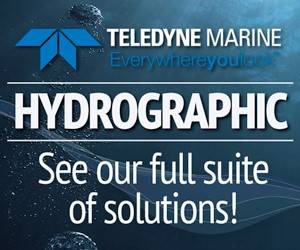Feature
Greenland’s Institute of Natural Resources
Greenland Bound:
Mapping Critical Mid-Range Depth with the SeaBat T50-R
When Dr. Diana Krawczyk and her team at Greenland’s Institute of Natural Resources needed to research in the waters around Greenland, it found a strong partner in Teledyne Marine’s SeaBat multibeam sonar system.
By Greg Trauthwein
R/V Sanna.
Photo by Fernando Ugarte/courtesy Greenland’s Institute of Natural ResourcesScientist Dr. Diana W. Krawczyk was educated as a Geographer Specialist in Paleoceanography in her native Poland, but in recent years she switched gears to Marine Geophysics and at the Greenland Institute of Natural Resources she was tasked to develop a seafloor modeling and benthic habit mapping program in Nuuk. “My responsibilities are two-fold: I'm responsible for the acoustic instrumentation of the research vessels and also the research part, which is coordination of the programs, mapping programs, as well as education and outreach activities,” she said in a recent interview with Marine Technology Reporter TV.
A few years ago, Dr. Krawczyk and her colleagues teamed with Teledyne Marine to procure and deploy it's SeaBat T50-R extended range multibeam sonar system to get the job done.
“This is a cool story, because as we were developing the mapping program with Greenland, we were in need of geophysical equipment to acquire spatial coverage data of the seafloor terrain,” said Dr. Krawczyk. “We were looking for a multibeam echosounder, and I was specifically interested in the type that can cover the water depth down to one kilometer as this is within the continental shelf, which covers a huge area in Greenland. (It also needed it to be) a reasonable price because I needed to apply for funding to get that equipment!”
When Dr. Krawczyk initiated the search, what she found were mostly shallow water multibeams or deepwater multibeams, systems that didn't really fit her project requirements.
“But then I learned that Teledyne had come up with a demo model of a medium water multibeam,” said Dr. Krawczyk. “We tested that in 2017 in Disko Bay, Greenland, mounted on a pole on our ship, and it was excellent. We got great data quality, and everything went right, so, we ended up buying that model (for installation on our research vessel) R/V Sanna.”
In order to ensure optimal results, R/V Sanna had to have its bow modified with two additional tons of steel. “That was like two tons of awesome to get the ship technologically advanced,” said Dr. Krawczyk. “The overarching goal of the use of this multibeam is to generate specific scientific knowledge of the seafloor for research, for advice (legislators), for education … for whatever the information is needed.”
The SeaBat T50-R“The funny thing about the T50 extended range is that it was sort of born in funny way,” said Uni Bull, Senior Product Manager, Multibeam and Single beam echosounders, Teledyne Reson. (When we develop products) “we usually have roadmaps (for development), but this one popped up out of nowhere.”
To complete its mission, the SeaBat T50-R Extended Range high-resolution multibeam sonar was procured, a system funded by Åge V. Jensens Fonde. R/V Sanna operates on the West Greenland coast, collecting data about Greenland’s marine resources and oceanographic environment.
Teledyne Reson previously had a SeaBat 7111, 1000-m rated multibeam system that was discontinued. “We didn't see a lot of traction in that mid-water segment market until the Danish Navy approached us and said, ‘we need to go to 800-900 meters,’” said Uni Bull, Senior Product Manager, Multibeam and Single beam echosounders, Teledyne Reson.
To fill the gap, Teledyne Reson took its standard T50, which is a shallow water multibeam, “probably considered the de facto standard in the industry,” added Bull, and developed an extended range version of the transmitter. “We increased the size of the transmitter, applied more power and lowered the frequency,” said Bull. “So when I say it popped out in the middle of nowhere, it was intended for the Danish Navy but it ended up also with the Greenland Institute of Natural Resources, which also needed to go to that (800 to 1000m) depth.
Problem Solving
Working in the world’s oceans is often described as one of the harshest and unhospitable places on the planet: working the waters in and around Greenland is a notch above that.
“I had been discussing the use of this equipment with my much more experienced colleague when we started the program, and he said that I don't need to worry about the equipment other than grounding of the ship,” said Dr. Krawczyk, noting “this is Greenland, there are shallow rocks and icebergs.”
As (bad) luck had it, an accident did happen.
“We managed to use this equipment (without incident) for two years, and then we had a ‘little accident’ in the harbor,” said Dr. Krawczyk. That ‘little accident’ ultimately destroyed the receiver during the heart of the pandemic and right before Dr. Krawczyk and her team were scheduled to depart on a research cruise.
This is when Bull and his Teledyne Reson colleagues stepped up to rapidly have a new unit shipped, installed, tested and calibrated to ensure that the Greenland research team didn’t miss a beat.
“I was a part of the (original) installation, I helped out,” said Bull, who naval background and knowledge of Greenland helped out. “I've done surveys in Greenland, so I know Greenland, I know how to work in Greenland and with the people around Nuuk. I ended up going to Greenland with one of our service engineers, and we did the installation and we also completed training onsite with Diana and her team.”
“I had excellent assistance from Teledyne,” said Dr. Krawczyk, noting that Teledyne teams from the UK and Denmark worked in tandem to work out some ‘bugs’ in the hardware and software “just about we were supposed to leave for the cruise. So it was just perfect, and we got some wonderful data,” said Dr. Krawczyk.
Bathymetry map (water depth in meters, see color scale) of one of the fiord branches showing a newly discovered landslide (white box).
The Results
Dr. Krawczyk was effusive in her praise for the Teledyne technology and team, noting that its multibeam had effectively introduced a new opportunity of creating high-resolution habitat maps of the ocean seafloor around Greenland, filling major knowledge gaps and providing baseline information on the sea bottom for the vast number of end-users in Greenland.
“Basically we pioneered this field of research in Greenland,” she said. “I managed to map nearly the entire Disko Bay region, which is almost 5,000 sq. km. We mapped similar fjords in the west and southwest Greenland, mostly the areas that are surveyed by the annual assessments of the Institute, and we discovered some amazing topographic features as well, such as a landslide nearby Nuuk, which nobody knew about.”
The team also discovered some large pockmark fields in the Disko Bay area, pockmark fields that could indicate, for example, the presence of hydrocarbons. “And we can also use our maps to delineate areas where there are deep sea corals or shrimp habitats, contributing further to the management plan of the seafloor and the marine resources,” she said. “I think we have produced amazing results, so, I'm very pleased.”
In October 2020 R/V Sanna carried out an expedition to map the seafloor of the Nuup Kangerlua system, South-West Greenland. The goal of this local effort was to create a complete map of the seafloor features, water depths and seabed (benthic) habitats of this large fjord system.
The Greenland Institute of Natural Resources
The Greenland Institute of Natural Resources conducts research into Arctic ecosystems, monitors the living resources and the environment in Greenland and advises the Government of Greenland and other authorities on sustainable exploitation of living resources and safeguarding the environment and biodiversity. The Institute has about 70 employees across three departments: Department of Fish and Shellfish, Department of Birds and Mammals, and Department of Environment and Mineral Resources. In addition is has a cross-disciplinary Danish/Greenlandic climate center: The Greenland Climate Research Center.
The climate research center is embedded in the Greenland Institute of Natural Resources, and conducts research into effects of climate change on the Arctic environment and Greenlandic society. “We communicate our research to the scientific communities, to the local communities, administrators, politicians, fishers, and hunters as well,” said Dr. Krawczyk. Primary funding for GINR comes from the government of Greenland, the Greenland Research Council, the European Union, as well as other Danish and Nordic fund resources.


